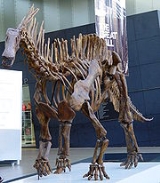
Dicraeosauridae
Encyclopedia
Dicraeosauridae is a family of sauropod dinosaurs known from the Late Jurassic
and Early Cretaceous
of Africa and South America. Currently only three genera
are recognised; the Jurassic South American genus Brachytrachelopan
, the Jurassic African Dicraeosaurus
and the South American Early Cretaceous Amargasaurus
, with its distinctive neck spines. All three animals are small by sauropod standards, with relatively short necks.
 McIntosh (1990) includes a number of genera within the subfamily Dicraeasaurinae of the family Diplodocidae, but many of these are now recognised as belonging to distinct families (Nemegtosauridae
McIntosh (1990) includes a number of genera within the subfamily Dicraeasaurinae of the family Diplodocidae, but many of these are now recognised as belonging to distinct families (Nemegtosauridae
and Rebbachisauridae
).
The group is described cladistically
as a stem-based taxon
defined as "The most inclusive clade containing Dicraeosaurus hansemanni Janensch 1914 but not Diplodocus longus
Marsh 1878" or as "all diplodocoids
more closely related to Dicraeosaurus hansemanni than to Diplodocus longus (Sereno 1998 p.63, Upchurch et al. 2004 p.304, Wilson 2005 p.35)
Late Jurassic
The Late Jurassic is the third epoch of the Jurassic Period, and it spans the geologic time from 161.2 ± 4.0 to 145.5 ± 4.0 million years ago , which is preserved in Upper Jurassic strata. In European lithostratigraphy, the name "Malm" indicates rocks of Late Jurassic age...
and Early Cretaceous
Early Cretaceous
The Early Cretaceous or the Lower Cretaceous , is the earlier or lower of the two major divisions of the Cretaceous...
of Africa and South America. Currently only three genera
Genus
In biology, a genus is a low-level taxonomic rank used in the biological classification of living and fossil organisms, which is an example of definition by genus and differentia...
are recognised; the Jurassic South American genus Brachytrachelopan
Brachytrachelopan
Brachytrachelopan is an unusual short-necked sauropod dinosaur from the latest Jurassic Period of Argentina. The holotype and only known specimen was collected from an erosional exposure of fluvial sandstone within the Cañadón Cálcero Formation on a hill approximately 25 km north-northeast...
, the Jurassic African Dicraeosaurus
Dicraeosaurus
Dicraeosaurus is a genus of small diplodocoid sauropod dinosaur. It was named for the spines on the back of the neck. The first fossil was described by paleontologist Werner Janensch in 1914.Unlike most diplodocoids, Dicraeosaurus had a large head with a relatively short and wide neck...
and the South American Early Cretaceous Amargasaurus
Amargasaurus
Amargasaurus is a genus of dicraeosaurid sauropod dinosaur from the Early Cretaceous Period of what is now South America. It was small for a sauropod, reaching 10 meters length. It would have been a quadrupedal herbivore with a long, low skull on the end of a long neck, much like its relative...
, with its distinctive neck spines. All three animals are small by sauropod standards, with relatively short necks.

Nemegtosauridae
Nemegtosauridae is a family of probably titanosaurian sauropod dinosaurs based originally on two late Cretaceous Mongolian species known only from their diplodocid-like skulls: Nemegtosaurus and Quaesitosaurus. Authorities disagree as to the relationship of these two genera with other sauropods,...
and Rebbachisauridae
Rebbachisauridae
Rebbachisauridae is a family of sauropod dinosaurs known from fragmentary fossil remains from the Cretaceous of South America, Africa, and Europe.-Taxonomy:...
).
The group is described cladistically
Cladistics
Cladistics is a method of classifying species of organisms into groups called clades, which consist of an ancestor organism and all its descendants . For example, birds, dinosaurs, crocodiles, and all descendants of their most recent common ancestor form a clade...
as a stem-based taxon
PhyloCode
The International Code of Phylogenetic Nomenclature, known as the PhyloCode for short, is a developing draft for a formal set of rules governing phylogenetic nomenclature...
defined as "The most inclusive clade containing Dicraeosaurus hansemanni Janensch 1914 but not Diplodocus longus
Diplodocus
Diplodocus , or )is a genus of diplodocid sauropod dinosaur whose fossils were first discovered in 1877 by S. W. Williston. The generic name, coined by Othniel Charles Marsh in 1878, is a Neo-Latin term derived from Greek "double" and "beam", in reference to its double-beamed chevron bones...
Marsh 1878" or as "all diplodocoids
Diplodocoidea
Diplodocoidea was a superfamily of sauropod dinosaurs, which included some of the longest animals of all time, including slender giants like Supersaurus, Diplodocus, Apatosaurus, and Amphicoelias...
more closely related to Dicraeosaurus hansemanni than to Diplodocus longus (Sereno 1998 p.63, Upchurch et al. 2004 p.304, Wilson 2005 p.35)

